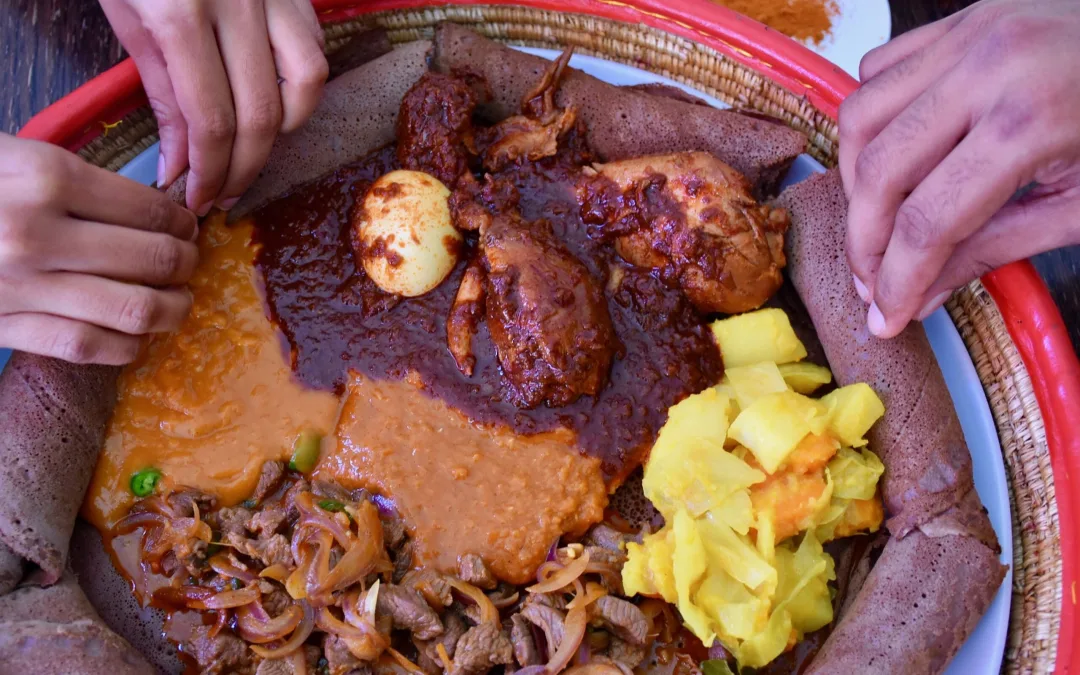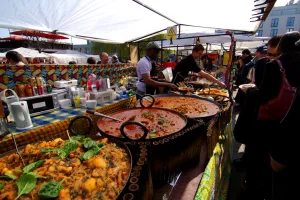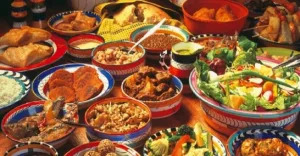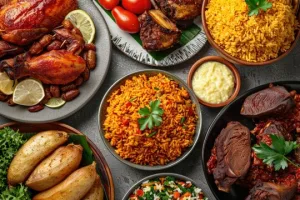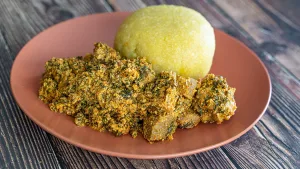African food culture and traditions are a vibrant reflection of the continent’s rich history, diverse communities, and deep-rooted connections to the land. Across the 54 nations of Africa, cuisine is more than sustenance—it’s a way of life, a means of storytelling, and a bridge that links generations. African food culture and traditions are deeply intertwined with rituals, festivals, and everyday life, offering a glimpse into the soul of a people who honor their heritage through the shared experience of food.
African food culture and traditions are deeply rooted in the continent’s diverse ethnic groups, climates, and historical influences. Food is often a communal experience, with meals serving as central gatherings for families and communities. Staple ingredients such as millet, sorghum, yams, cassava, maize, and rice form the foundation of many dishes, complemented by vegetables, legumes, and spices. Meals like jollof rice, injera with stews, and couscous reflect regional variations, while traditional cooking methods like slow stewing and grilling over open flames highlight a respect for natural flavors.
Food also holds significant cultural and spiritual importance in African traditions. Festivals, weddings, and rites of passage often feature elaborate feasts symbolizing unity and prosperity. Traditional beverages, such as palm wine and hibiscus tea, are shared during celebrations. The passing of culinary knowledge through generations ensures the preservation of identity and heritage, making African food culture a vibrant and integral part of life on the continent.
Importance of food in African culture and traditions
Food holds immense importance in African culture and traditions, serving not only as sustenance but also as a means of fostering community, celebrating spirituality, and preserving heritage. In many African societies, food is intricately linked to social identity, cultural practices, and the values of respect and sharing. Below are several ways in which food plays a central role in African life:
- Symbol of Hospitality
Food is a cornerstone of hospitality in African culture. Offering food to guests is seen as a sign of respect and generosity. In many communities, refusing food offered by a host can be seen as rude or disrespectful. Guests are treated with great honor, and meals are an essential part of their welcome. - Social Cohesion and Family Bonding
Sharing a meal is an important way to build relationships and reinforce family ties. In many African traditions, families eat together, reinforcing a sense of belonging and unity. During communal meals, discussions, storytelling, and bonding take place, helping to preserve traditions and pass down knowledge across generations. - Cultural Identity and Heritage Preservation
Traditional foods are a vital part of African identity. Each ethnic group has unique dishes, recipes, and cooking techniques that are passed down through generations. These dishes often carry historical significance, linking present-day Africans to their ancestors and ancestral lands. - Ceremonial and Religious Significance
Food plays a critical role in ceremonies, rituals, and religious observances. In African traditional religions, food offerings are made to ancestors and spirits to seek blessings or to give thanks. Food is also integral to celebrations such as weddings, births, and harvest festivals, marking significant life events and milestones. - Healing and Medicinal Uses
Many African cultures view food as a form of medicine. Certain herbs, roots, and plants are believed to have healing properties and are used in traditional African medicine to treat ailments or to promote overall well-being. Food is often prepared with care to support the health of individuals, especially during sickness or pregnancy. - Expression of Gratitude and Generosity
In times of abundance, food is often shared with neighbors, friends, and even strangers. This generosity helps to reinforce a sense of community and the interconnectedness of people. In many African cultures, food is a medium through which people express gratitude, both to others and to the divine. - Cultural Celebrations and Festivals
Festivals and cultural celebrations often revolve around food, with elaborate feasts marking these occasions. These events allow people to showcase their culinary skills, pass on traditional recipes, and celebrate their cultural pride. Food is a symbol of joy, marking both the triumphs and the challenges faced by communities. - Connection to the Land and Agriculture
The agricultural practices of many African communities are directly linked to food traditions. Seasonal crops, harvests, and local farming techniques are central to the food system, with communities honoring the land for providing sustenance. Food also reflects the natural resources available in each region, further strengthening the connection between people and their environment.
Food in African culture transcends the act of eating; it is a powerful symbol of hospitality, identity, healing, and community. Through food, Africans celebrate their rich traditions, honor their ancestors, and strengthen their social bonds. It is not merely about nourishment but about sustaining cultural values and connecting with others on a deeper level.
Traditional African Meals and Their Cultural Significance
Traditional African meals are rich in diversity, with each region offering unique dishes that reflect the continent’s cultural practices, agricultural practices, and social values. These meals are more than just food; they carry deep cultural significance, often tied to history, identity, and community life. Here are some traditional African meals and their cultural importance:
- Jollof Rice (West Africa)
Jollof rice is a beloved dish across West Africa, especially in countries like Nigeria, Ghana, and Senegal. Made from rice, tomatoes, onions, and various spices, it is often served at major celebrations such as weddings, festivals, and family gatherings. The dish represents unity, as it is often prepared in large quantities for communal sharing. The “Jollof rivalry” between countries like Nigeria and Ghana reflects the dish’s cultural significance, with each nation claiming the best recipe. - Injera with Doro Wat (Ethiopia)
Injera is a sour, spongy flatbread made from teff flour, served with stews like Doro Wat, a spicy chicken stew. This dish is an iconic symbol of Ethiopian culture and is often eaten during religious holidays, including major feasts like Ethiopian Orthodox fasting holidays. The communal style of eating, where family and friends share from a large platter, emphasizes social bonding and respect for tradition. Doro Wat is considered a celebratory dish, representing abundance and gratitude. - Bunny Chow (South Africa)
Bunny chow is a fast food dish originating from Durban, South Africa. It consists of a hollowed-out loaf of bread filled with curry, typically made from beans, chicken, or lamb. The dish was created by Indian immigrants in the 1940s but has become a staple of South African street food. It reflects the multicultural influences in South Africa, blending African, Indian, and colonial traditions into a unique culinary experience. - Pounded Yam and Egusi Soup (Nigeria)
Pounded yam is a dish made by pounding boiled yam until it becomes smooth and stretchy, typically paired with a thick, hearty soup such as Egusi soup made from ground melon seeds, vegetables, and meat or fish. This dish is a staple in many Nigerian homes and is often eaten during special occasions and ceremonies. It symbolizes strength and unity, as it is typically shared by family members and close friends in a communal setting. - Sadza (Zimbabwe)
Sadza is a staple food in Zimbabwe, made from maize meal that is cooked to a thick porridge-like consistency. It is usually served with meat, vegetables, or a stew, and is a key part of everyday meals. In Zimbabwean culture, sharing a meal of sadza represents hospitality, and it is often eaten during family gatherings, ceremonies, and celebrations. The dish reflects the centrality of maize (corn) to the local diet and economy. - Biltong (Southern Africa)
Biltong is dried, cured meat, similar to jerky, and is a popular snack throughout Southern Africa, particularly in South Africa, Namibia, and Zimbabwe. Traditionally, it was a way to preserve meat before refrigeration. The dish has become a symbol of South African heritage, with regional variations in flavor and preparation methods. It is often shared among friends and family during social gatherings and sporting events, representing a sense of camaraderie and pride in local food traditions. - Fufu and Light Soup (West Africa)
Fufu is a starchy dish made from cassava, yams, or plantains that are boiled, pounded, and formed into a smooth dough-like consistency. It is typically eaten with light soup, a broth-based dish made with meat, fish, or vegetables. Fufu is a communal dish, often shared by family members during large meals. It holds cultural significance in many West African countries like Ghana, Nigeria, and Ivory Coast, where it symbolizes family unity and hospitality. - Sorghum Porridge (East Africa)
In East Africa, sorghum porridge is a common breakfast dish, particularly in countries like Ethiopia and Uganda. Made from ground sorghum grains, the porridge is often served with milk, honey, or fruits. Sorghum, as one of the oldest cultivated crops in Africa, represents a deep connection to the land and traditional agricultural practices. It is often eaten as a means of nourishment before the start of the day’s work. - Maize Meal and Beans (Southern Africa)
In Southern African countries like Zambia and Malawi, maize meal (known locally as nshima or nsima) served with beans is a staple food. The combination is a practical and nutritious meal that sustains families through long days of hard labor, especially in rural areas. The simplicity of the dish reflects the resourcefulness of the people, as it uses easily accessible and affordable ingredients.
Traditional African meals are not just about food but serve as a means of preserving cultural identity, fostering social bonds, and celebrating history. Whether it’s the communal sharing of dishes like Jollof rice or Injera or the deep cultural symbolism in meals like Pounded Yam and Egusi soup, food in African culture reflects a rich tapestry of beliefs, practices, and values. Through these dishes, Africans continue to honor their ancestors, celebrate achievements, and create lasting memories within their communities.
Popular African Dishes Across Regions
Africa’s culinary landscape is incredibly diverse, with each region offering a rich array of dishes that reflect local ingredients, cultures, and traditions. Below are some popular African dishes, categorized by region, showcasing the continent’s vibrant and varied food culture:
West Africa
- Jollof Rice (Nigeria, Ghana, Senegal)
A beloved dish in many West African countries, jollof rice is made with rice, tomatoes, onions, and a mix of spices like thyme, curry, and bay leaves. It is often served with grilled meats, fried plantains, or vegetables. Jollof rice is a staple at parties, weddings, and other celebrations, especially in Nigeria and Ghana, where the rivalry over whose version is the best is common. - Pounded Yam and Egusi Soup (Nigeria)
Pounded yam is a starchy dish made by pounding boiled yam until it becomes stretchy and smooth, and is often paired with egusi soup, made from ground melon seeds, spinach, and meats like goat, beef, or fish. This dish is popular in Nigerian and other West African cultures, often eaten during special occasions and large family gatherings. - Yassa (Senegal)
Yassa is a Senegalese dish consisting of marinated chicken or fish, often cooked in a tangy sauce made from onions, mustard, garlic, lemon juice, and olive oil. It is typically served with rice and is one of the most iconic dishes in Senegalese cuisine, known for its distinctive and bold flavors. - Fufu and Light Soup (Ghana, Ivory Coast)
Fufu is a dough-like dish made by pounding boiled cassava, yams, or plantains. It is traditionally served with light soup—a broth-based soup typically made with chicken, goat, or fish, flavored with tomatoes, peppers, and spices. Fufu is a communal dish, often eaten in family gatherings.
East Africa
- Injera with Doro Wat (Ethiopia)
Injera is a spongy, sour flatbread made from teff flour, and it serves as a base for various stews, including the famous Doro Wat—spicy chicken stew cooked with hard-boiled eggs and flavored with berbere spices. This dish is typically eaten during major holidays like Ethiopian Orthodox Christian holidays, and sharing it is a mark of hospitality and community. - Sambusas (Horn of Africa)
Sambusas are deep-fried pastry pockets filled with spiced meats, vegetables, or lentils. Common across East Africa, particularly in Ethiopia, Somalia, and Kenya, sambusas are a popular street food or appetizer. They reflect the influence of Arab and Indian cuisines on the region. - Ugali (Kenya, Tanzania)
Ugali, a dish made from maize meal, is a staple food in Kenya, Tanzania, and several other East African countries. It is similar to polenta and is often served with stews or vegetables. In Kenya, it is commonly paired with sukuma (collard greens) or nyama choma (grilled meat), forming a balanced and satisfying meal. - Nyama Choma (Kenya, Tanzania)
Nyama Choma, or “grilled meat,” is a popular dish in East Africa, particularly in Kenya and Tanzania. It involves marinating chunks of beef, goat, or chicken with a blend of spices before grilling over an open flame. It is often served with vegetables, rice, or ugali and is a favorite during celebrations or gatherings.
North Africa
- Couscous (Morocco, Algeria, Tunisia)
Couscous is a staple dish in North Africa, made from steamed semolina wheat, and typically served with a stew made from lamb, chicken, or vegetables. In Morocco, it is often served during the Friday meal, symbolizing family unity. The dish is popular for its versatility, as it can be paired with various proteins or vegetables. - Tagine (Morocco)
Tagine is both a slow-cooked stew and the clay pot in which it is traditionally cooked. The dish can include lamb, chicken, or beef, and is typically flavored with a mixture of sweet and savory spices, such as saffron, cinnamon, and cumin. Vegetables, fruits like dried apricots or dates, and nuts are often added, creating a rich, complex flavor profile. Tagine is considered a symbol of Moroccan cuisine and hospitality. - Harira (Morocco)
Harira is a thick, flavorful soup traditionally eaten during Ramadan to break the fast. Made from tomatoes, lentils, chickpeas, and lamb or beef, it is spiced with cinnamon, turmeric, and ginger. This hearty soup is often paired with dates or flatbread and represents the warmth and generosity of Moroccan hospitality. - Mechoui (Algeria, Tunisia)
Mechoui is a dish of slow-roasted lamb, often cooked whole, and typically served with flatbread. It is especially popular in Algeria and Tunisia and is commonly eaten during large family gatherings or special celebrations like weddings and religious festivals.
Southern Africa
- Bunny Chow (South Africa)
Bunny chow is a unique South African fast food dish, originating from Durban. It consists of a hollowed-out loaf of bread filled with curry, usually made from beans, chicken, or lamb. Initially created by Indian immigrants in South Africa, it has become a national dish that reflects the country’s multicultural influence. - Braai (South Africa)
Braai, or South African barbecue, is a social and cultural event centered around grilling meats like boerewors (a traditional sausage), steak, chicken, and chops over an open fire. This dish reflects South Africa’s love for outdoor cooking and is often enjoyed with sides like pap (maize meal), salads, and chutney. - Pap and Chakalaka (South Africa, Zimbabwe)
Pap, a type of maize porridge, is a beloved dish in South Africa and Zimbabwe. It is typically served with chakalaka, a spicy vegetable relish made with onions, tomatoes, peppers, and beans. Pap and chakalaka is a filling and flavorful dish, often enjoyed during festive occasions and family meals. - Vetkoek (South Africa)
Vetkoek is a deep-fried dough bread, similar to a doughnut but without the sugar coating. It can be eaten plain or filled with savory fillings like minced meat or curry. Often sold as street food, vetkoek is a popular snack or meal in South Africa.
Central Africa
- Moambe Chicken (Democratic Republic of Congo)
Moambe chicken, or “chicken in palm nut sauce,” is a rich and flavorful dish originating in Central Africa. The chicken is cooked in a thick sauce made from palm nuts, onions, garlic, and various spices. It is commonly served with rice or cassava and is a key dish for gatherings and celebrations. - Poulet DG (Cameroon)
Poulet DG, or “Director’s Chicken,” is a dish served during special occasions in Cameroon. The chicken is cooked in a sauce made from tomatoes, onions, plantains, and vegetables. It is often considered a luxurious dish due to the cost of ingredients and is usually reserved for festive events.
African cuisine reflects the continent’s diversity, with each region contributing unique dishes that represent local cultures, ingredients, and culinary traditions. From the rich stews of North Africa to the communal meals of West Africa and the grilled specialties of Southern Africa, African dishes provide a flavorful journey through history and tradition. These meals not only serve as nourishment but also as an expression of hospitality, community, and celebration across the continent.
Traditional Ingredients in African Cooking
Traditional ingredients in African cooking are as diverse as the continent itself, with each region boasting unique staples that form the foundation of its cuisine. These ingredients are deeply rooted in the continent’s agricultural practices, climate, and cultural traditions. Below is a list of some of the key traditional ingredients commonly used across Africa, and their significance in African cooking:
- Cassava
Cassava is a versatile root vegetable widely used in many African countries, especially in West and Central Africa. It is the primary ingredient in dishes like fufu (a starchy dough-like dish), garri (a dried, ground form of cassava), and tapioca. Cassava provides a reliable source of carbohydrates and is often paired with stews and soups. In many African cultures, it holds economic and cultural significance, as it is a staple food that can be prepared in a variety of ways. - Maize (Corn)
Maize is another staple food that features prominently in African cooking, particularly in Southern, Eastern, and West Africa. It is commonly used to make dishes like sadza, nshima, and banku. Maize is also ground into flour to make porridge, bread, and other baked goods. Its versatility and nutritional value make it a crucial food source, especially in rural areas where it is often grown locally. - Yams
Yams are a vital part of West African cuisine, where they are used in dishes like pounded yam, which is eaten with soups and stews. Yams are a rich source of carbohydrates and are often seen as a symbol of abundance. The tuber is also used in various forms, including boiled, roasted, or fried, and is a key part of many ceremonial feasts and celebrations. - Sorghum
Sorghum is one of Africa’s oldest cultivated grains and is an important food source in countries like Ethiopia, Sudan, and Mali. It is used to make porridge, flatbreads, and even fermented beverages like t’ej (an Ethiopian honey wine). Sorghum is high in fiber, making it a nutritious choice in African diets. It is also drought-resistant, making it an important crop in arid regions. - Millet
Millet is another ancient grain widely used across Africa, especially in countries like Ethiopia, Niger, and Chad. It is typically made into porridge, couscous, or used in baking bread. Millet is known for its high nutritional value, including protein and iron, and is particularly important in areas with poor soil or water scarcity, where it is often more resilient than other crops. - Palm Oil
Palm oil is a common cooking oil in West and Central Africa, especially in countries like Nigeria, Cameroon, and Ghana. It is used in soups, stews, and frying, adding a rich, reddish color and deep flavor to dishes. Palm oil is also a key ingredient in the preparation of dishes like jollof rice, egusi soup, and many other regional specialties.
7.Peanuts (Groundnuts)
Peanuts are widely used in African cooking, both as a snack and as a key ingredient in savory dishes like groundnut stew (popular in West and Central Africa). Groundnuts add a creamy texture and rich flavor to sauces and soups. They are also an important source of protein and fat, making them a valuable part of the diet in many African countries.
- Okra
Okra is a popular vegetable in African cooking, especially in West Africa. It is often used in soups and stews, where its mucilaginous (sticky) texture helps thicken sauces. Okra is a key ingredient in dishes like gumbo and is valued for its ability to absorb flavors while adding its own distinctive taste and texture. - Chili Peppers
Chili peppers are used widely in African cuisine, adding heat and depth of flavor to many dishes. From the fiery piri-piri peppers in East Africa to the bird’s eye chilies in West Africa, these peppers are central to many sauces, marinades, and stews. In addition to flavoring food, they are also believed to have medicinal properties, helping to preserve food and improve digestion. - Fruits (Mango, Papaya, Baobab)
Africa is home to a wealth of indigenous fruits that are integral to traditional diets. Mangoes and papayas are popular throughout the continent, enjoyed both fresh and in dishes like salads, juices, and desserts. Baobab fruit, with its tangy flavor and high vitamin C content, is used in drinks and supplements. These fruits not only provide nutritional value but are also often associated with cultural symbolism and rituals. - Beans and Legumes
Beans, lentils, and other legumes are common ingredients in African cooking. In countries like Kenya, Uganda, and Nigeria, beans are used to prepare hearty stews and soups that serve as the main protein source in many households. Common types of beans include black-eyed peas, cowpeas, and kidney beans. Legumes are valued for their high protein and fiber content, making them a critical component of the diet, especially in vegetarian meals.
12.Spices and Herbs
African cuisine is rich in spices and herbs, many of which are indigenous to the continent. Common spices include ginger, garlic, cumin, coriander, turmeric, and cinnamon. African cuisines also feature a variety of unique spice blends such as berbere from Ethiopia, ras el hanout from Morocco, and suya spice from West Africa. These spices are often used to marinate meats, season stews, and flavor rice and vegetable dishes, contributing to the complexity of African flavors.
The traditional ingredients used in African cooking are deeply intertwined with the continent’s history, geography, and culture. They provide a rich tapestry of flavors, textures, and nutritional benefits, forming the foundation of diverse and vibrant cuisines.
These ingredients, from cassava and maize to spices like cumin and berbere, are central to the African way of cooking and have traveled across borders, influencing global food culture in significant ways.
African Food in Global Context
African food has increasingly made its mark on the global culinary scene, reflecting the continent’s rich diversity and evolving influence on international cuisine. With its distinct flavors, ingredients, and cooking techniques, African food is becoming more widely recognized and appreciated in different parts of the world. This rise in popularity can be attributed to factors like immigration, globalization, and the growing interest in diverse and sustainable eating habits. Here’s a look at African food in a global context:
- Global Culinary Recognition
African food has started to gain prominence in global food markets, with many African dishes becoming popular in international cities. In places like New York, London, and Paris, African restaurants and food trucks are serving traditional dishes such as jollof rice, injera, and Moroccan tagine.
The inclusion of African-inspired menus in high-end restaurants is also growing, with renowned chefs embracing the use of traditional African spices, grains, and vegetables. This has led to a broader understanding and appreciation of African culinary traditions beyond the continent.
- Fusion Cuisine
The blending of African ingredients and cooking styles with other global cuisines has resulted in the rise of fusion food, a trend that highlights Africa’s adaptability in the modern culinary world. For example, African spices like berbere, harissa, and curry are being incorporated into Western and Asian dishes, creating unique flavors that appeal to diverse palates. This fusion movement introduces African food to new audiences, making it more accessible and exciting to explore. - Health and Sustainability Trends
As the world becomes more conscious of health and sustainability, African food’s emphasis on plant-based ingredients, whole grains, and nutritious vegetables aligns well with current global trends. Dishes like sorghum porridge, millet, and chickpea stews highlight the nutritional value of African staples.
Additionally, African cuisine often incorporates seasonal and locally sourced ingredients, which resonate with growing global interests in sustainability and organic eating. African food is increasingly viewed as a sustainable and healthy alternative to heavily processed foods in many parts of the world.
- Diaspora Influence
The African diaspora plays a significant role in the global spread of African food, as millions of Africans have moved to different parts of the world over the centuries. Immigrant communities continue to cook traditional dishes in their new homes, while adapting to local ingredients and cooking methods.
This has led to the rise of African food in countries such as the United States, the UK, and Canada, where African immigrants and their descendants are keeping their culinary traditions alive. Festivals, cookbooks, and cooking shows from African chefs have further contributed to the global visibility of African food.
- Culinary Tourism
As tourism continues to grow, many people are eager to explore Africa through its culinary experiences. Culinary tourism has become a key aspect of African travel, with food tours offering travelers the chance to taste authentic local dishes, learn about food production, and interact with chefs and farmers.
From the street food of Morocco to the seafood of Senegal, African cuisine is becoming an integral part of the travel experience, giving visitors a deeper understanding of the continent’s culture and people.
- Social Media and Food Influencers
Social media platforms have played a crucial role in bringing African food to a global audience. Food influencers and bloggers from around the world are showcasing African recipes, often with modern twists, to their followers. Platforms like Instagram, YouTube, and TikTok allow for the easy sharing of vibrant photos and cooking videos, increasing visibility and engagement with African dishes.
Through these digital platforms, African chefs and home cooks are able to reach global audiences, introducing them to the tastes, stories, and cultural significance behind African meals.
African food’s global rise reflects the continent’s ability to adapt, influence, and enrich the world’s culinary landscape. With its bold flavors, diverse ingredients, and deep cultural ties, African cuisine is making its mark in international kitchens, food markets, and dining experiences.
Whether through fusion, health-conscious trends, or culinary tourism, African food continues to gain recognition, offering the world a richer understanding of the continent’s cultural heritage and its contributions to global gastronomy.
Conclusion
The rich diversity of the continent is beautifully reflected in its cuisines, where flavors, ingredients, and preparation methods vary widely yet remain deeply meaningful. African food culture and traditions highlight the importance of community, storytelling, and heritage, making every meal more than just sustenance—it’s a celebration of identity and unity.

